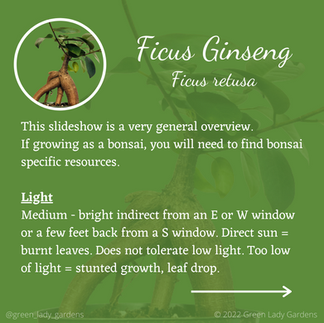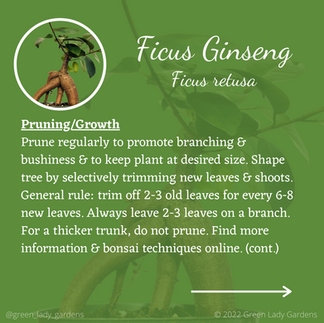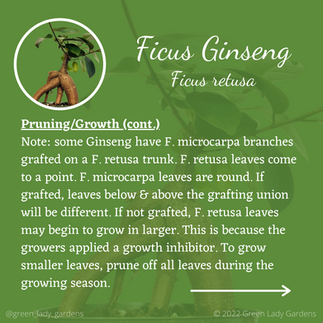Ficus Ginseng Care
- Green Lady Gardens
- Feb 16, 2022
- 2 min read
Updated: Nov 17, 2023
Ficus retusa, commonly referred to as ficus ginseng or ginseng ficus, is a very forgiving and easy beginner bonsai. Growing it as a bonsai means you will prune the tree to maintain a specific size and shape. It also means you will do different things with fertilizer and repotting that you don't do with most other houseplants. You will have to consult bonsai specific resources to learn more. There is entirely too much information to cover in this slideshow. If you don't want to grow your Ficus retusa as a bonsai, you can let it rage and grow it as you would other houseplants.
Gardener's Path has a great introduction to bonsai including how bonsai are made, styles, and growing and pruning basics.
Save this slideshow from our Instagram account & easily share it with others.
Light
Medium - bright indirect from an E or W window or a few feet back from a S window. Direct sun = burnt leaves. Does not tolerate low light. Too low of light = stunted growth, leaf drop.
Water
Water when soil is slightly dry, 30% max, with lukewarm or tepid water. Cold water will shock the roots & may result in yellow leaves & leaf loss. Can tolerate some over & underwatering. Overwatering = yellow leaves, leaf drop, mushy stems &/or trunk. Underwatering = brown & crunchy spots on leaves, yellowing older leaves.
Pruning/Growth
Prune regularly to promote branching & bushiness & to keep plant at desired size. Shape tree by selectively trimming new leaves & shoots. General rule: trim off 2-3 old leaves for every 6-8 new leaves. Always leave 2-3 leaves on a branch. For a thicker trunk, do not prune. Find more information & bonsai techniques online.
Note: some Ginseng have F. microcarpa branches grafted on a F. retusa trunk. F. retusa leaves come to a point. F. microcarpa leaves are round. If grafted, leaves below & above the grafting union will be different. If not grafted, F. retusa leaves may begin to grow in larger. This is because the growers applied a growth inhibitor. To grow smaller leaves, prune off all leaves during the growing season.
Humidity
Thrives in high humidity but does fine in average household humidity. In nature, aerial roots grow vertically from the trunk & branches & down into the soil. Growing aerial roots at home requires constant moisture or extremely high humidity. It is likely only possible in an enclosure. Low humidity = leaf loss, new aerial roots dry out.
Soil & Potting
Use a gritty soil that drains well. You can grow your plant in a small pot with drainage & "let it rage." Or, you can treat it as a bonsai. In this case you will have to consult bonsai resources. There are different soil recipes, pot types, repotting & fertilizing rules, & methods of displaying the roots to consider & learn about.
Temperature
Keep at a steady & consistently warm temperature. 60 - 80℉. Does not tolerate cold drafts, temperature under 55℉, temperature swings, or heat vents. Leaf loss = too cold, temperature is not stable.


























Comments